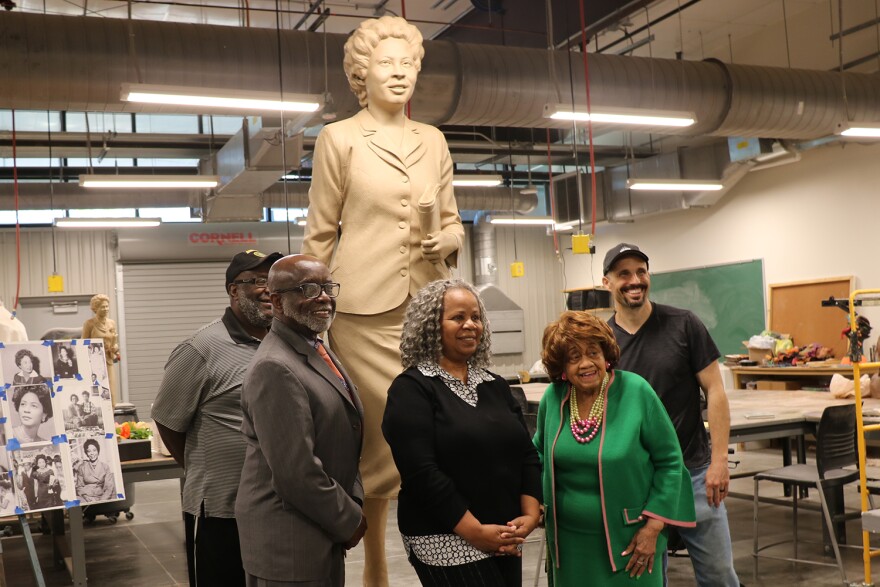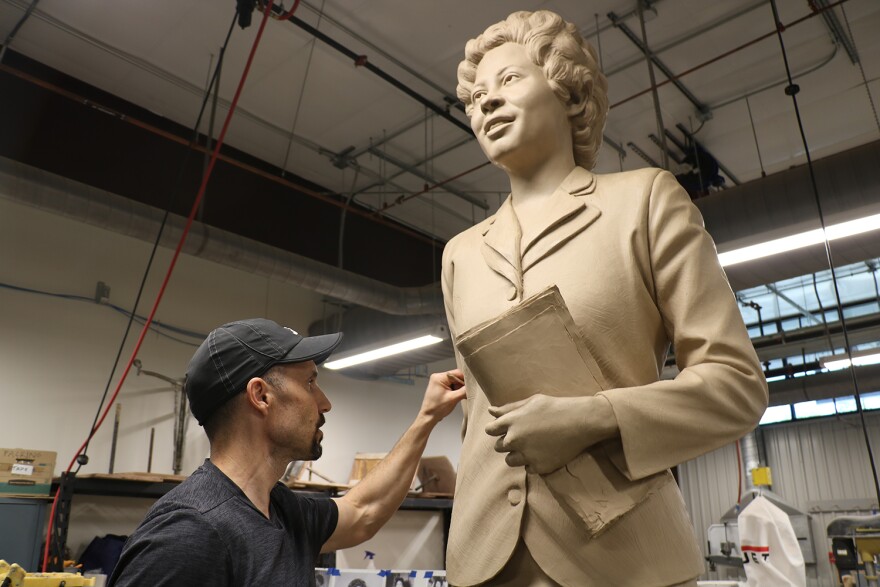An artist creating a statue of Arkansas civil rights leader Daisy Bates which will eventually be on display at the U.S. Capitol is spending this week in Little Rock. Since Monday, Benjamin Victor of Boise, Idaho has been letting the public watch as he works on an eight-foot clay model that will be used to cast the bronze statue.
Inside a studio at the Windgate Center of Art + Design at the University of Arkansas at Little Rock, he has also been showing it to people interested in the project, including friends and associates of Bates. Several he met with on Tuesday expressed their joy about how the design has come out.
"For me, as a sculptor, it is very humbling to approach a project like this and want to do justice to somebody like Daisy," Victor said in an interview with KUAR News. "There’s a familiarity, a love and a smile that she had that just brought a warmth to that fire she also had as a leader."
Bates was best known for her role mentoring the nine Black students who desegregated Central High School in 1957. She and her husband L.C. Bates also published the Arkansas State Press newspaper.
Victor says he started his research by reading Bates' autobiography "The Long Shadow of Little Rock," which was published in 1962. It details her traumatic childhood in the southern Arkansas town of Huttig and her perspective on the crisis at the formerly all-white school. Gov. Orval Faubus called out the Arkansas National Guard to block the Black students from entering Central High, with President Dwight D. Eisenhower responding by federalizing the National Guard and sending in U.S. Army troops
While working on the clay model, both at his home studio in Idaho and at UA Little Rock, a montage of photos taped to a board has been kept nearby showing Bates from many different angles. The primary image that inspired Victor's design, he said, is a photo of Bates leading a demonstration, walking forward with a newspaper in her left arm. His clay model also features her holding a newspaper, though at this point it's blank.

Eventually, Victor said an authentic vintage newspaper page will be chosen and scanned onto the statue. As discussed at a meeting of the Arkansas Statuary Hall Steering Committee in November, the newspaper must be an exact replica, not something compiled for the statue. The newspaper page selected must then be submitted for approval by the U.S. Capitol architect's office as part of an effort to ensure authenticity.
Victor said his visit to Little Rock, including the National Park Service's Central High School National Historic Site, is helping him as he considers final modifications to the model.
"Touring Little Rock today, getting to see the museum and all the remembrance that has been done for the Little Rock Nine, we’ve obviously come a long way. But, I think that Daisy Bates, if she were here today, would say that we still have a long ways to go," Victor said. "That’s what this piece is about. It's that her legacy can carry on even after she’s gone.”
Bates died in 1999 at the age of 84.
Janis F. Kearney, who was publisher of the Arkansas State Press in its later years, was among those who visited with Victor on Tuesday, got a close look at the full-size clay model and posed for photos.

“I am overwhelmed. I am filled with emotions," Kearney said. "This is something that I’ve dreamed of, having her legacy really known around the world and around the country. People know her but I have always thought there was so much more for people to know about Daisy Bates.”
While Bates is an established figure in Arkansas history, Kearney said placing a statue of her in the U.S. Capitol will greatly expand her legacy.
"Putting her in Washington, DC puts her on a whole different level and one that I think is a long time coming," Kearney said.
The Arkansas Legislature approved replacing the state's statues in the nation's Capitol with Bates and music legend Johnny Cash in 2019. Gov. Asa Hutchinson then formed the Statuary Hall Steering Committee to select the artists who would create the statues and oversee the process.
One member of the committee with Kearney on Tuesday was Charles King. He serves as president of the Daisy Bates House Museum Foundation Board which oversees the home that L.C. and Daisy Bates lived in at 1207 W. 28th Street in Little Rock.
The house was significant during the integration crisis as the place where the nine Black students would meet before and after school. A volunteer guard committee watched over the house amid threats of violence. NAACP attorney Thurgood Marshall, who later became the first Black justice on the U.S. Supreme Court, was a regular there. Rev. Martin Luther King Jr. also stayed in the house when he came to see Ernest Green become the first Black student to graduate from Central High in 1958.
“I have been so pleased when I think about Mr. Victor’s trip here and the excitement that it's bringing in the community. It makes me even more encouraged to know that people now truly appreciate the efforts, the work, the really backbreaking, life-changing effort that Daisy Bates did to make this state and this world a better place,” King said.
Mary Louise Williams, 94, also serves on the board for the house and came to see the model. She had been friends with Bates, traveled with her and lived nearby.

“I’m hoping that this will motivate young people,” said Williams. "Mrs. Bates was a self-taught woman, her husband was the educator. But she had a mind of helping people. She also wanted to show people that you can be whatever you want to, but you had to work at it."
It's hoped the statues of Bates and Cash will be ready in December for an unveiling ceremony in Washington, DC. Each state has two statues on display. Arkansas' current ones are more than a century old and are of attorney Uriah Rose and former governor and U.S. Senator James P. Clark.
The Political Animals Club of Little Rock organized a reception on Wednesday evening with Victor and Cash sculptor Kevin Kresse. Victor will have two remaining days when the public is available to come watch as he continues working on the Bates clay model at the Windgate Center:
- Thursday, April 28, 1-5 p.m.
- Friday, April 29, 1-3 p.m.
The center is located on the University of Arkansas at Little Rock campus at 2801 S. University Avenue. Groups can be scheduled specific times to visit by emailing Amber Crawford at the Arkansas Secretary of State's office.







